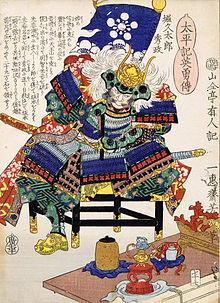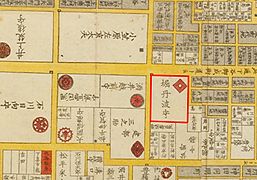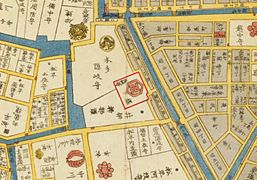Hori (clan)
The Hori ( Japanese 堀 氏 , Hori-shi ) were a family of the Japanese sword nobility ( Buke ) from the province of Mino , which was derived from Fujiwara no Uona .
With an income of 17,000 Koku , the wealthiest branch of the Hori residing in Iida ( Nagano Prefecture ) belonged to the smaller Tozama daimyo of the Edo period . At the beginning of the Edo period, however, the family had a total income of around 500,000 koku until after a dispute between Hori Tadatoshi, Naokiyo and Naoyori in 1610 the shogun Tokugawa Ieyasu deprived them of their territories and banished the former both.
genealogy
Main branch
- Hidemasa ( 秀 政 ; 1553-1590) served Oda Nobunaga and then Toyotomi Hideyoshi , from whom he received the Nagahama Castle ( Ōmi ) in 1581 . The following year he took part in the Battle of Yamazaki against Akechi Mitsuhide and then took over Sakamoto Castle . In 1583 he received the domain Sawayama (Ōmi) with 90,000 Koku and in 1585 Kitanojō ( Echizen ) with 180,850 Koku. Hidemasa died during the siege of Odawara .
- Hideharu ( 秀 治 ; 1567-1606), a son of Hidemasas, received after the death of his father Kitanojō and then with the transfer of Uesugi Kagekatsu to Aizu in 1598, whose rich domain Kasugayama ( Echigo ) with 300,000 Koku, from the later of the fief Takada (Echigo ) emerged.
- Tadatoshi ( 忠 俊 ; 1596–1622), a son of Hideharu, was deposed in 1610 and exiled in the province of Mutsu .
Side branch in Iida
- Chikayoshi ( 親 良 ; 1580–1637), a son of Hidemasa, received the domain Zaōdō with 40,000 Koku in 1598, handed it over to his adoptive son Tsuruchiyo ( 鶴 千代 ; 1598? -1606) in 1611 due to illness , received the domain Mooka ( Shimotsuke ) in 1611 and then in 1627 Karasuyama (Shimotsuke). His descendants were transferred to Iida ( Shinano ) with 17,000 koku in 1672 and resided there until 1868, most recently with the honorary title of Iwami no kami . Then Vice Count .
Side branch in Tamatori
- Toshishige ( 利 重 ; 1581–1638), Hidemasa's brother, founded another line. He resided in Tamatori ( Hitachi ) with 10,000 koku until 1679.
Secondary branch (okuda)
-
Naomasa ( 直 政 ; 1547-1609) was the son of Okuda Naozumi and the sister of Hidemasas, served the latter and in 1585 took the name Hori. He later served Toyotomi Hideyoshi , who gave him Sanjō (Echigo) with 50,000 koku in 1598 . Naomasa had several sons who became the progenitors of three branches.
- Naokiyo / Naotsugu ( 直 清 / 直 次 ; 1573-1641), Naomasa's eldest son, received Sanjō, was deposed in 1610 and banished to the province of Dewa , with which the main line of this branch ceased.
-
Naoyori ( 直 寄 ; 1577–1639) received Sakato (Echigo) in 1598, was transferred to Iiyama (Shinano) in 1610 , resided in Nagaoka (Echigo) from 1616 , and in Murakami (Echigo) from 1618 . The family stayed there until the death of his grandson Naotsugu ( 直 政 ; 1614–1638).
- Naotoki ( 直 時 ; 1616–1643), Nayori's second son, received Yasuda in 1639, later exchanged under his son to Muramatsu (Echigo), where his descendants resided in a permanent house ( jinya ) until 1868 . Then Vice Count.
- Naoyuki ( 直 之 ; 1585–1642) was the progenitor of a branch who resided with his son from 1642 in Kariya ( Kazusa ), from 1668 in Yawata (Kazusa) and from 1698 to 1868 in Shiiya (Echigo) with 10,000 koku in a permanent house .
- Naoshige ( 直 重 ; 1585-1617) took part in the Battle of Sekigahara in 1600 , for which he received the domain of Yahagi (Shimousa) and then in the siege of Osaka for which he received Suzaka (Shinano) with 12,000 koku in 1615 , where his family until 1868 resided in a permanent house. Then Vice Count.
After 1868, the family again took the old name Okuda ( 奥 田 ).
Iida Hori Residence in Edo
literature
- Papinot, Edmond: Historical and Geographical Dictionary of Japan. Reprinted by Tuttle, 1972 edition of 1910 edition, ISBN 0-8048-0996-8 .
Remarks
- ↑ Today a district of Hikone .
- ↑ Today a district of Jōetsu .
- ↑ Often there is also the indication 450,000 Koku, which however also includes the dependent domains Murakami with 90,000 Koku and Shibata with 60,000 Koku of the follower daimyō ( yoriki daimyō ) Murakami Yoshiaki and Mizoguchi Hidekatsu.
- ↑ Today as Nishi-Zaō ("West-Zaō") a district of Nagaoka .
- ↑ Today a district of Tsukuba .
- ↑ Today a district of Minamiuonuma .
- ↑ Today a district of Gosen .
- ↑ Today a district of Isumi .
- ↑ Today a district of Ichihara .
- ↑ Today a district of Kashiwazaki .
- ↑ Today as Moto-Yahagi ("Old Yahagi") a district of Katori .
Individual evidence
- ^ Tetsu Takada: Iida-jo. In: Masayuki Miura (ed.): Shiro to jinya. Tokoku-hen. Gakken, Tokyo 2006, ISBN 4-05-604378-7 .
- ↑ 堀 秀 政 . In: 朝日 日本 歴 史 人物 事 典 at kotobank.jp. Retrieved May 24, 2015 (Japanese).
- ↑ 春日 山 藩 . In: 日本 大 百科全書 at kotobank.jp. Retrieved May 25, 2015 (Japanese).
- ↑ 堀 秀 治 . In: デ ジ タ ル 版 日本人 名 大 辞典 + Plus at kotobank.jp. Retrieved May 24, 2015 (Japanese).
- ↑ 堀 忠 俊 . デ ジ タ ル 版 日本人 名 大 辞典 + Plus at kotobank.jp, accessed on May 24, 2015 (Japanese).
- ↑ 堀 利 重 . In: デ ジ タ ル 版 日本人 名 大 辞典 + Plus at kotobank.jp. Retrieved April 25, 2015 (Japanese).
- ↑ 堀 直 次 . In: デ ジ タ ル 版 日本人 名 大 辞典 + Plus at kotobank.jp. Retrieved May 24, 2015 (Japanese).
- ↑ 村 松 藩 . In: 藩 名 ・ 旧 国 名 が わ か る 事 典 at kotobank.jp. Retrieved May 24, 2015 (Japanese).
- ↑ 堀 直 重 . In: デ ジ タ ル 版 日本人 名 大 辞典 + Plus at kotobank.jp. Retrieved May 24, 2015 (Japanese).
- ↑ a b c Masayuki Miura (ed.): Shiro to jinya. Tokoku-hen. Gakken, 2006. ISBN 4-05-604378-7 .
- ↑ a b Excerpt from the “Shitaya” district map from around 1850.
- ↑ Excerpt from the district map "Nihonbashi-minami" from around 1850.







